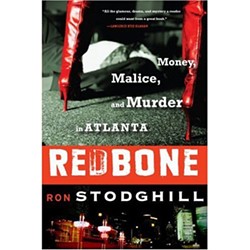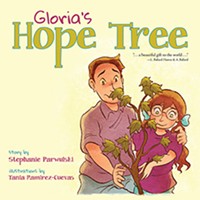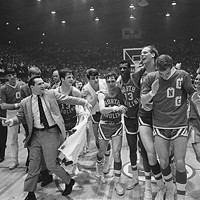Most nonfiction, especially this genre of crime story, involves many different sides, numerous people and significant pieces that the writer must put together in a coherent, readable narrative. Ron Stodghill's Redbone is just such a complicated story about the 1996 death of a young black entrepreneur in Atlanta.
As an experienced reporter for several newspapers, including The Charlotte Observer and the Detroit Free Press, Stodghill knew when he heard about it that this was a powerful story. (In the interest of full disclosure, I first read excerpts of Redbone when I was finishing an MFA in Creative Writing at Queens University of Charlotte, and Stodghill was just starting the program.)
"I didn't cover the (Lance) Herndon case for any publication," Stodghill says. "I was working as a senior writer for Time when my dad told me about the case. He had seen a bit of the trial on Court TV and was mesmerized by all these attractive black women taking the stand and testifying in this case about this black millionaire who was found bludgeoned to death in his home. I didn't see the stuff on TV, but I was curious enough to Google the guy."
At the time, Stodghill was living in New York but went to Atlanta to look into the case. What became clear, he says "was that like so many other blacks over the past three decades, Herndon had migrated down South from the North to advance his professional interests and had done so in a big way. The whole reverse migration of African-Americans had always fascinated me because my own family had left Tennessee back in the late 1930s and 1940s for Detroit and jobs in the auto plants. Those jobs, and the education they afforded us, brought us into the middle class.
"It seemed to me," he continues, "that Atlanta, later in the century, had experienced the same kind of boom, only this one was white-collar. What struck me about Lance is that, despite being nestled away in his gated suburban enclave in a city that folks call the Black Mecca, he died as brutally as some dude on a ghetto street corner."
Herndon had made a fortune with his consulting company, Access, Inc., in the early days of computer systems. By all accounts, he was an attractive and generous man as well as a top-notch salesman. He had many personal and business acquaintances but relatively few close friends. He often spent a great deal of money on entertaining acquaintances, especially female friends, even during the period of his marriage.
Herndon was killed either late on the night of Aug. 7 or in the early morning hours of Aug. 8, 1996. Evidence in the case was scarce and circumstantial, although detectives uncovered a tangled web of personal and professional relationships as well as problems within the business.
In January of 1998, charges were brought against a woman with whom Herndon was having an affair, Dionne Baugh. Baugh, a native of Jamaica who had been living in Atlanta, met Herndon at his lavish birthday party in April 1996. She was petite and the type of light-skinned black woman that Herndon liked -- he called them "redbones." After they began a relationship, Herndon gave her the use of a car and a credit card. Evidence presented in the case showed that at the same time, Herndon maintained at least one other relationship and occasionally still had sex with a longtime female friend who also occasionally did office work for his company.
Stodghill maintains a straightforward, reportorial style in relating this story, and he refuses to sensationalize the more lurid details. His experience as a business writer also comes into play, giving this part of the story more depth.
"The book," he says, "was born out of two central questions: How did a man who seemed to have the world at his fingertips die such a horrific death? And what role did place -- Atlanta as the epicenter of a modern black nouveau riche culture -- play in his death?"
If there is a weakness in this book, it's that Stodghill concentrates on Baugh's first trial and explains the results of her appeal in a short epilogue. However, it's easy to understand that he likely did that because the first trial probably revealed the most about all the participants. After her original conviction was overturned and a subsequent trial was declared a mistrial, Baugh pleaded guilty in 2004 to a lesser charge and was sentenced to 10 years. As a reader, I would have liked to find out more about why she finally decided to plead guilty. But because this book succeeds on so many other levels, it's difficult to quibble with the writer's decision.
Stodghill doesn't want to pigeonhole this as a "true crime," but the book does share the properties of the best of that genre. Like Erik Larson's The Devil in the White City and John Berendt's Midnight in the Garden of Good and Evil, Stodghill takes the reader much further than the crime committed into a fascinating examination of a unique aspect of our culture.
Redbone: Money, Malice, and Murder in Atlanta
by Ron Stodghill
Amistad, 240 pages, $25.95
Speaking of 5.00000
-
A Family Affair
Dec 12, 2007 -

What If the Water Runs Out?
Dec 12, 2007 -
Body Talk
Dec 12, 2007 - More »
Latest in Books
More by Ann Wicker
-
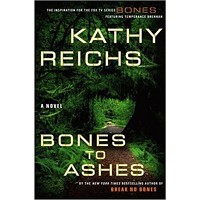
Boning Up
Oct 24, 2007 -

Get Your Weird On
Sep 26, 2007 -

A threefer of keepers
Jun 20, 2007 - More »
Calendar
-

NEW WINDOW GALLERY-Pat Rhea-ACRYLIC PAINTINGS-April 05-30 2024 VALDESE, NC 28690 @ New Window Gallery/Play It Again Records
- Through April 30, 12 p.m.
-
Derek Hough - Symphony Of Dance @ Ovens Auditorium
-
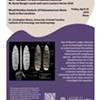
"Blood Residue Analysis of Paleoamerican Stone Tools in the Carolinas" @ Native American Studies Center
- Fri., April 26, 12-1 p.m.
-

ARTS RENAISSANCE, a GALA supporting the ARTS in South Carolina @ the Columbia Museum of ART
-
 The Piano Guys @ Ovens Auditorium
The Piano Guys @ Ovens Auditorium

